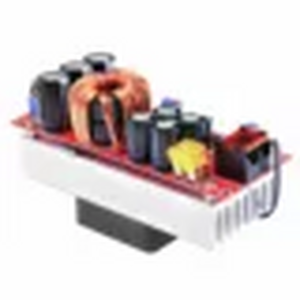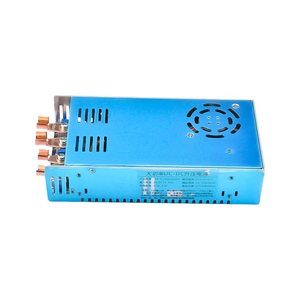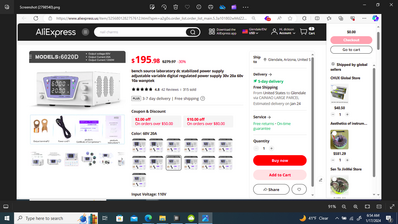PLEASE NOTE: If you had an account with the previous forum, it has been ported to the new Genetry website!
You will need to reset the password to access the new forum. Click Log In → Forgot Password → enter your username or forum email address → click Email Reset Link.
I bought 2 of the 1800-watt dc-dc boost charger modules from Aliexpress for 14-18 dollars each and they have heat sink and fan to help keep them cool
the idea is to charge the 48-volt LiFePO4 battery when needed....
I have some 5k tech direct prebuilt 24-volt LiFePO4 cabinet batteries that I can hook into series to get 48-volt output fairly easily.
and just ordered some more 175 amp Anderson connectors for that part...
I am planning on hooking up a couple of them with quick disconnects to make them a bit more portable on an insulated plastic board or something.
i want to use some excess solar PV power from one of my DIY 24-volt ESS to charge some of the other pre-built batteries... (which I plan to hook in series to get 48 volt out of the pre-built batteries)
24-volt to 48-volt
as I often have excess 24-volt power at the moment...
I been using 4 of the same boost converter for 4 years boosting 12vdc to 45vdc . I only charging 5 amps or 60 watts . The first 3 was set to 600 watts and all catch on fire . Andy at Off grid garage had a review about 3 years ago . He do not use for chargung battery .
sounds like they may only be good for a temporary transfer of power when you can watch them...
don't need a darn fire issue!!
I bought another one (DC-DC charger converter) https://www.aliexpress.com/item/3256805813194816.html?spm=a2g0o.order_detail.order_detail_item.4.2c46f19ctT7h2P
Product selling points
1: Widely used
2: Input current: 100A (maximum)
3: Input power: 2000W (maximum)
4: Easy to use
5: Conversion efficiency: 92-96% (efficiency is related to input and output voltage and current)
Main parameters:
1. Product name: High power non isolated DC boost module power supply.
2. Product model: 100A2000W.
3. Input voltage: DC12V-60V.
4. Input current: 100A (maximum).
5. Input power: 2000W (maximum).
6. No load power consumption: less than 2W.
7. Output voltage: DC15V-80V.
8. Output current: 50A (maximum).
9. Output power: 1850W (maximum).
10. Conversion efficiency: 92-96% (efficiency is related to input and output voltage and current).
11. Working temperature: -20~50 ℃.
Instructions for use:
1. Input+represents the positive pole of the power input, and input - represents the negative pole of the power input.
2. Output+is the positive pole of the power output, and output - is the negative pole of the power output.
3. When constant current and current limiting are required for the output of this module, the input and output ground wires must be connected separately and cannot share the same wire.
4. Adjustable range of undervoltage: DC10.5V-50V (clockwise to decrease, counterclockwise to increase). Firstly, adjust the undervoltage to the minimum, then adjust the input voltage to the required undervoltage protection value, and then slowly adjust it counterclockwise to increase. When the undervoltage indicator light is turned on, adjust it back one to two turns and power it on again.
The undervoltage protection function is mainly used for:
(1) Input battery power is mainly used to protect the battery from damage caused by over discharge.
(2) Power supply with unstable input voltage, such as solar panels, wind turbines, car generators, etc., ensures that the power supply and equipment are not damaged due to low input voltage,
(3) This function also has a certain MPPT function when used on solar panels and wind turbines, which can track the maximum power point when the input power is low, achieving efficient input.
5. Adjustable range of constant voltage: DC15-80V (clockwise decrease, counterclockwise increase). Please adjust the voltage to the required voltage when outputting no-load before connecting to the load (constant voltage power supply should be adjusted to the maximum constant current).
6. Adjustable range of constant current: 5A-50A (clockwise decrease, counterclockwise increase), first adjust the output voltage to the voltage required by the load without load (the load voltage should be 2-3V higher than the load voltage during constant current), adjust the current to the minimum, and then slowly adjust the current to the current required by the load.
8. This power supply is equipped with an intelligent temperature controlled fan. When the power temperature reaches around 55-60 degrees, the fan automatically turns on, and when the power temperature drops to around 50 degrees, the fan automatically turns off.
9. The input voltage cannot fall below 12V or exceed 60V (please reduce the load appropriately when the input voltage falls below 12V).
10. The maximum input current cannot exceed 100A, and the power cannot exceed 2000W.
11. When using, it is necessary to ensure that the input voltage is at least 2V lower than the output voltage.
When using a switching power supply or other secondary power supply, please ensure that the power supply power should be greater than twice the power supply of this module.
13. When protecting the power supply from overcurrent or undervoltage, the output still has a voltage close to the input value, and the protection only means that the power supply does not boost.
14. The output blue indicator light will only light up when the power supply is boosted.
15. Important note: Please try not to use inputs below 12V as much as possible. If the output voltage exceeds 60V with full load, the output power should be appropriately reduced when the input and output pressure difference is large. The larger the pressure difference, the lower the power efficiency and the greater the heat generation.
16. Output load instructions: When inputting 12V (input current 100A, output below 60V, maximum output can carry a load of around 1100W), when inputting 24V or above (maximum input current 85A, maximum output can carry a load of below 1850W), the test load is a resistive load, and other loads depend on the situation.
17. Input current and power instructions: Under no circumstances should the input current exceed 100A. When the input working current exceeds 75A or the input power exceeds 1000W, heat dissipation should be strengthened (by sticking the lower part of the power supply to a metal surface for heat dissipation).
Calculation of input current: Input current=[(output voltage X output current)/conversion efficiency around 0.93]/input voltage,
Explanation: When calculating constant current output, no-load voltage should be selected.
inventory
1 * Booster power module
that I will try later but it has been so frigid cold that just scooping snow and feeding the critters has me tired and cold
I scooped the snow from driveway yesterday 30 below zero with wind chill and this morning and the road grader came along and buried the end of my driveway again...
This is why i run a 24v system and not a 48v system. It's more efficient for me to just run on 24v because that's what everything else uses. A 48v inverter is more efficient than a 24v one -- but if you're having to convert other things to 48v, you're losing more than you're gaining.
Also, if you're wanting to use excess solar -- why not just charge the series'd 48v bank directly by the solar charger? (AKA, put a DC transfer switch so you can select which bank to charge). Assuming your solar charger is auto-sensing...
This will be much more efficient than stepping the voltage around multiple times.
I don't have an mppt solar charger hooked up for the 48-volt right now (it's snowed in another garage right now)... but have an excess stored at 24-volts and have other 48-volt inverters that I could utilize more of the 48-volt stored in the 24 volt batteries...by charging them up at 48 volts...
it is possible to just series connect them after the fact to hook up to the 48-volt inverter ... but if I just set up at 48-volt and draw excess power stored in the 24-volt ,,,, I was thinking I could utilize more of it....
have 8 prebuilt 24-volt batteries that are capable of series connection to utilize in a 48-volt inverter...
right now it is a bit too cold to do much outside below zero every day with wind chill...
so I was trying to utilize more of the 24-volt electric but wanted to series connect some of the 24-volt pre-built batteries... as they are not being utilized sufficiently right now...
the terrible cold and excess snow limits what is feasible at the moment....
the skid loader is the coldest piece of iron to use when it is below zero to move snow... and still have to hand scoop the snow etc so not feasible to do 48-volt mppt right now...
the prebuilt 24-volt batteries are already in the solar power shed so is more feasible to hook in series to make 48-volt
they are on wheels and weigh about 180 pounds each
I also have a golf cart lifepo4 charger that works good to charge the 24-volt LiFePO4 batteries also
but still trying to utilize some at 48-volt....
all is done off-grid so only solar PV panels doing all the charging via 24-volt dssr20's which are not mppt but are controlled by the sbms0.
I have outlets wired to a 120/240 from a LF 15,000 watt 24-volt inverter but only using 120-volt AC things right now...at the off-grid farm
another one (DC-DC charger converter) https://www.aliexpress.com/item/3256805813194816.html?spm=a2g0o.order_detail.order_detail_item.4.2c46f19ctT7h2P
I like to know how this dc to dc boost converter works for you . I still have the 12vdc to 45vdc boost converter working good . I now series connect the lower voltage battery to 60 vdc and 72 vdc and use a dedicated battery charger like a riden6024 and (wanptek charger that Andy use ) and maisheng charger . A dedicated charger will only charge to SOC 80 and will not damage the battery . There is a major problem with connecting battery in series is that each battery bank must be monitor when running a load . If I connect 2 24vdc battery bank in series to 48vdc and then run a heavy load .... one of the 24vdc battery will sag to 21vdc and the other 24vdc battery will jump to 27 vdc . I must then switch off the series battery . The same thing happen when fast charging where one 24vdc battery will charge to 29vdc and the other will drop to 20vdc . Battery connected in parallel do not have this charging problem .
the prebuilt 24-volt batteries are already in the solar power shed so is more feasible to hook in series to make 48-volt .
I know you do not like Andy but Andy will disassemble the 24vdc battery bank and assemble to 48vdc and not have the series 48vdc battery running with one of the 24vdc battery sag to 22vdc when running a heavy load . A golf cart lifepo4 charger is a dedicated charger that will bulk charge to SOC 80 and not damage the battery .
@dickson In parallel they still stay at 24-volt, or closer to 27 volts or slightly more but in series connection I could get the 48-volt....
Andy and does all kinds of things but purposely does things wrong to get attention....he is into marketing type stuff but he is funny at times....
yes,
the other charger I bought from Aliexpress I will have to get back to you on that. it has a little more promise I think to charge at higher voltage....i am waiting on the 175 amp Anderson plugs for that....
@dickson the riden chargers work good at the 27.6-volts or more say 28.4-volts charging of the battery packs,,,, but to leave charging for long periods of time ??? not sure about using for higher voltage like 54.6 to 56.8.... have not used them that way....
the dedicated golf cart lifepo4 charger >>> I have connected to a busbar with Anderson disconnects. it works good for the 27.6-volt charging and automatically shuts down when complete. but I only have one of those...
not sure about using for higher voltage like 54.6 to 56.8.... have not used them that way..
I use one Riden6024 everyday charging to 59vdc at 4.9 amps . The Riden6024 fail if charging at over 6 amps and fail if it charging the battery and is running the inverter at the same time . The lithium-ion battery is not being used by the inverter when charging . I have a dc switch to remove the battery from the inverter bus bar when charging . The wanptek charger will charge to 61vdc at 10 amps and can be running the inverter at the same time .
Which Wanptec charger does that high voltage???
did not want to fry the Riden chargers >>>> I like the Riden units but they are fairly expensive now..
I had a bench charger before (don't remember the brand right now) but it quit within 30 days so I was able to send it back to Amazon...
I have the 20A 60vdc Wanptec from Aliexpress . I use this to charge my two 24vdc in series when one battery is 29vdc the other is 22vdc and the setting is 10A 59vdc . The 24v battery will both be 28vdc after an hour . Now the price is under 200 dollars . I charge the 16s lithium-ion battery at 18A and 61vdc . I also have a Wanptec 100vdc 10A to charge the 72vdc series lithium-ion battery . IT automatically stop bulk charge at SOC 80 . The battery never overheat and NOT cause thermal runaway at SOC 80 or less . The dedicated Dakota LiFePO charger also stop bulk charge at SOC 80 . I do not know if the GS12kw has the 4 stage charge setting for safety .
that 6020d looks like a good bench charger from Wamptec....
I looked at it on aliexpress just now
yes I do not believe they have all the bugs worked out of running 2 of the gs12 doing two different things yet.....
but have no information as they are posting no new information....
I would never use a Powerjack as a charger or ATS for the time being.... even if it has that function built in >>> which some do
I will only use PowerJack as an inverter >>> nothing more
going with a separate charger makes more sense to me....
blaming the electrical wiring in the barn did not seem to be the likely cause of blowing up GS stuff.... but the clueless will be great part-changers in the future....
a dead short due to improper insulation is a good theory of the issue/problem....at least it is possible but still no new YouTube video of fixing them running together .... still suspect back feed problem
the grid always has the bigger kick so a bad wiring design will never overpower the grid....
I do not have any inverters connected to the grid and have no plans to do so....
South Dakota electric companies have no incentive to hook up my solar PV to their system so why would I want to buy into their expensive wiring requirements
Mr ed says so....🤣


